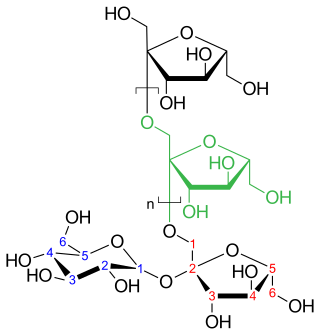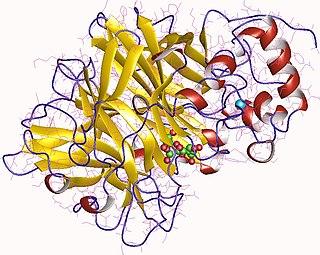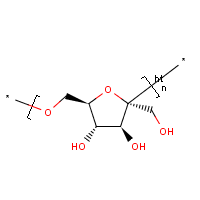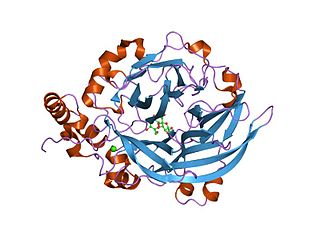
Inulins are a group of naturally occurring polysaccharides produced by many types of plants, industrially most often extracted from chicory. The inulins belong to a class of dietary fibers known as fructans. Inulin is used by some plants as a means of storing energy and is typically found in roots or rhizomes. Most plants that synthesize and store inulin do not store other forms of carbohydrate such as starch. In the United States in 2018, the Food and Drug Administration approved inulin as a dietary fiber ingredient used to improve the nutritional value of manufactured food products. Using inulin to measure kidney function is the "gold standard" for comparison with other means of estimating glomerular filtration rate.

A fructan is a polymer of fructose molecules. Fructans with a short chain length are known as fructooligosaccharides. Fructans can be found in over 12% of the angiosperms including both monocots and dicots such as agave, artichokes, asparagus, leeks, garlic, onions, yacón, jícama, barley and wheat.

α-Glucosidase (EC 3.2.1.20, is a glucosidase located in the brush border of the small intestine that acts upon α bonds:

Fructosides are glycosides where the glycone group is fructose.
Glucose-1,6-bisphosphate synthase is a type of enzyme called a phosphotransferase and is involved in mammalian starch and sucrose metabolism. It catalyzes the transfer of a phosphate group from 1,3-bisphosphoglycerate to glucose-1-phosphate, yielding 3-phosphoglycerate and glucose-1,6-bisphosphate.
In enzymology, an isomaltulose synthase is an enzyme that catalyzes the chemical reaction
The enzyme levan fructotransferase (DFA-IV-forming) catalyzes the following process:
In enzymology, a 2,1-fructan:2,1-fructan 1-fructosyltransferase is an enzyme that catalyzes the chemical reaction
In enzymology, a 6G-fructosyltransferase is an enzyme that catalyzes the chemical reaction
In enzymology, an aldose beta-D-fructosyltransferase is an enzyme that catalyzes the chemical reaction
In enzymology, a cellulose synthase (GDP-forming) is an enzyme that catalyzes the chemical reaction

Levansucrase is an enzyme that catalyzes the chemical reaction

In enzymology, a maltose phosphorylase is an enzyme that catalyzes the chemical reaction

Sucrose-phosphate synthase (SPS) is a plant enzyme involved in sucrose biosynthesis. Specifically, this enzyme catalyzes the transfer of a hexosyl group from uridine diphosphate glucose (UDP-glucose) to D-fructose 6-phosphate to form UDP and D-sucrose-6-phosphate. This reversible step acts as the key regulatory control point in sucrose biosynthesis, and is an excellent example of various key enzyme regulation strategies such as allosteric control and reversible phosphorylation.
In enzymology, a sucrose:sucrose fructosyltransferase is an enzyme that catalyzes the chemical reaction

In enzymology, a sucrose synthase is an enzyme that catalyzes the chemical reaction

5'-AMP-activated protein kinase subunit beta-1 is an enzyme that in humans is encoded by the PRKAB1 gene.

Levan is a naturally occurring fructan present in many plants and microorganisms. This polymer is made up of fructose, a monosaccharide sugar, connected by 2,6 beta glycosidic linkages. Levan can have both branched and linear structures of relatively low molecular weight. Branched levan forms a very small, sphere-like structure with basal chains 9 units long. The 2,1 branching allows methyl ethers to form and create a spherical shape. The ends of levan also tend to contain a glucosyl residue. Branched levan tends to be more stable than linear polysaccharides. However, the amount of branching and length of polymerization tends to vary among different species. The shortest levan is 6-kestose, a chain of two fructose molecules and a terminal glucose molecule.
David Sidney Feingold was an American biochemist.

In molecular biology, glycoside hydrolase family 68 is a family of glycoside hydrolases.










